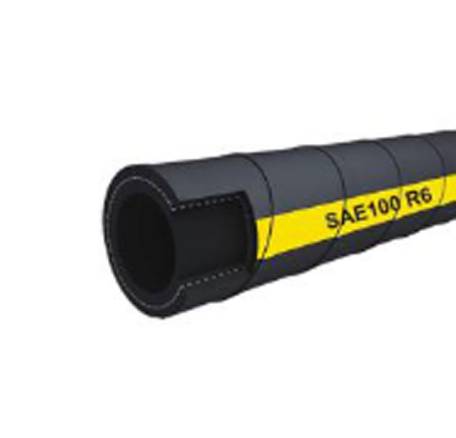Rubber Hydraulic Hose is a common and important element in countless industrial and mobile machines. It serves as the plumbing that routes hydraulic fluid between tanks, pumps, valves, cylinders and other fluid-power components. Plus, hose is generally straightforward to route and install, and it absorbs vibration and dampens noise. Hose assemblies—hose with couplings attached to the ends—are relatively simple to make. And if specified properly and not overly abused, hose can work trouble-free for hundreds of thousands of pressure cycles.
Hydraulic Hoses consist of an inner tube, one or more layers of reinforcement, and an outer cover. Each constituent should be selected with the intended application in mind. Typical operating and performance parameters include the size, temperature, fluid type, pressure-holding capacity and environment, to name a few.
The inner tube contains the fluid and keeps it from leaking to the outside. The type of hydraulic fluid generally dictates the tube material. Usually it is nitrile or synthetic rubber for petroleum-based hydraulic oil. But alternatives like Viton or Teflon are used with synthetic fluids like phosphate ester.
The cover protects the reinforcement layer. One consideration when determining the cover material is resistance to attack from outside influences like chemicals, salt water, steam, UV radiation and ozone. Common cover materials include nitrile, neoprene and PVC, among others.
When a hose rubs against adjacent structures or other hoses, friction and abrasion can be concerns. That’s because if the cover wears away and exposes the reinforcement to mechanical and chemical attack, the hose will often quickly fail. A number of manufacturers offer tough, abrasion-resistant covers to help prevent harm.

Hydraulic Hoses
Temperature extremes can also affect material selection for both tube and cover . Standard Hose is typically rated for operation between –40° to 212° F. Extreme cold makes rubber and elastomers brittle and prone to cracking; extreme heat can soften and weaken the materials. Manufacturers offer alternative materials like low-temperature synthetic rubbers or PKR for extreme cold and chlorinated polyethylene for higher temperatures.
Rubber hydraulic hose is often referred to by the type of reinforcement: “braided” or “spiral.” In either case, reinforcement layers are tightly wrapped upon the tube with special winding machines. Applying the cover over the reinforcement completes the hose.
Spiral-wound hydraulic hose is for demanding, high-pressure applications, generally from about 4,000 to 8,000 psi. They have alternating, tightly wound spiral layers of high-tensile steel wire. The wires in the second layer are laid at an opposing angle to the first, and the pattern repeats for each subsequent layer.
Two types are 4-wire and 6-wire versions, based on the number of reinforcing layers. Four-layer spiral wound hydraulic hose is extremely strong and is common in high-pressure, large-diameter hose assemblies. Six-wire hose is used for even more-extreme requirements. Inner-diameter sizes tend to run from about 0.38-in. to 2.0 to 3.0-in. ID, depending on the manufacturer and specific type.
The demand for ever-larger, off-road equipment was the impetus behind the development of spiral hydraulic hose. Today, it is well-suited for applications that see extremely high impulse pressures. As just one example, hydrostatic drives on large dozers and earth movers often rely on four and six-wire spiral hydraulic hoses.
The downside to spiral hose, beside the cost, is it lacks flexibility Because of rigid, multi-layer construction, the hose is quite stiff. As a result, large 6-wire spiral hose is sometimes euphemistically referred to as “flexible pipe.”
Copyright © Hengshui Huiya New-Mat Technology Co., Ltd. All Rights Reserved Sitemap
